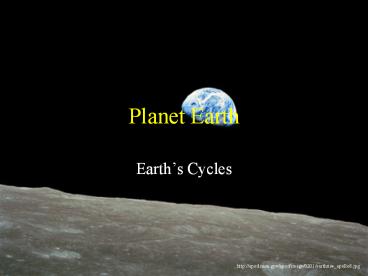Planet Earth - PowerPoint PPT Presentation
Title:
Planet Earth
Description:
Planet Earth Earth s Cycles http://apod.nasa.gov/apod/image/0201/earthrise_apollo8.jpg – PowerPoint PPT presentation
Number of Views:54
Avg rating:3.0/5.0
Title: Planet Earth
1
Planet Earth
- Earths Cycles
http//apod.nasa.gov/apod/image/0201/earthrise_apo
llo8.jpg
2
Seasons and Sunlight
- What is the solar angle of incidence for the
equator for the globe on the left? - 90
- 66.5
- 47
- 43
- The globe on the left represents
- Summer Solstice
- Winter Solstice
- Equinox and cannot tell if it is the spring or
fall - Not enough information
http//www.physicalgeography.net/fundamentals/imag
es/earth_sun_angles.gif
3
Seasons and Sunlight
- What is the solar angle of incidence for the
equator for the globe on the right? - 90
- 66.5
- 47
- 43
- The globe on the right represents
- Summer Solstice
- Winter Solstice
- Equinox and cannot tell if it is the spring or
fall - Not enough information
http//www.physicalgeography.net/fundamentals/imag
es/earth_sun_angles.gif
4
Direction of Rotation
A
B
- If you are looking down at the North Pole, does
the earth spin - Counterclockwise
- Clockwise
http//www.flutrackers.com/forum/attachment.php?at
tachmentid1512d1176083504
5
Eccentricity
- 100,000 year cycle
- Winter in North at Perihelion, and therefore
shorter than summer - Low eccentricity of 0.005
- High eccentricity of 0.058
- Mean eccentricity of 0.028
- Present eccentricity 0.017
- Moving towards low centricity - warming
Perihelion
Aphelion
http//en.wikipedia.org/wiki/FileEccentricity_hal
f.svg
6
Obliquity
- Tilt of the Axis
- 41,000 year cycle
- Minimum tilt is 21.1º
- Maximum tilt is 24.5º
- Currently at 23.5º
- Tilt is decreasing - cooling
http//upload.wikimedia.org/wikipedia/commons/6/61
/AxialTiltObliquity.png
7
Precession
- Wobble like a top
- Completes the wobble every 21,000 years
- Other north stars, Thuban in Draco and Vega in
Lyra - Top 10 sec
- Both 33 sec
http//stardate.org/images/gallery/d_procession.jp
g
8
Milankovitch Cycles
- These three cycles, in combination, can alter
climate - Eccentricity
- Obliquity
- Precession
- Milankovitch 2.38 min
http//www.cgd.ucar.edu/research/highlights/sectio
n/milankovitch.jpg
9
Questions?
10
Earth/Moon/Sun System
- Milankovitch Cycles Eccentricity Earths
distance from the sun varies, with an average of
93,000,000 miles - Johannes Keplers 2nd law of Equal Areas
- Sweep
http//outreach.atnf.csiro.au/education/senior/cos
micengine/images/cosmoimg/kepler2ndlaw.gif
11
The Moon
- Large Satellite Hypothesis
- planetary habitability is enhanced by the
presence of a large satellite - axial stability of a planet also enhances
habitability
http//www.dailyflier.com/astro/earth-mars.JPG
12
The Moon
- Compare to Mars
- Moons of Mars are so small, they cannot form a
sphere - Deimos (dread) smaller and further satellite
- Phobos (fear) larger and closer satellite
Phobos
Deimos
http//upload.wikimedia.org/wikipedia/commons/2/23
/Mars_Moons_Orbit_distance_flipped.jpeg http//www
.lpi.usra.edu/expmars/activities/phobosFS.gif http
//www.astro.keele.ac.uk/rdj/planets/images/Deimo
s-viking1.jpg
13
The Moon
- Formation of the moon
- Before 1969, hypotheses why Earth had such a
large satellite - Fission Hypothesis
- Capture Hypothesis
- Co-Formation Hypothesis
- Giant Impact Hypothesis
- NoMoon (2.14 min)
http//exoplanet.as.arizona.edu/lclose/teaching/a
202/lect5.html
14
The Moon
- Lunar Landings
- Returned with moon rocks
- Composition of rocks similar to surface of Earth
- Best fit hypothesis, Giant Impact Hypothesis
- Angular Momentum
- Composition of Moon
- Age of Rocks (younger than Earth by 100-300
million years) - Scale (lt2 sec)
http//www.fas.org/irp/imint/docs/rst/Sect19/moons
im.jpg
15
The Moon
- Gravitation pull of Moon (also pulls land)
- Centrifugal forces barycenter is pivotal point
- Centrifugal (17 sec)
- Centrifugal1 (7.27 min)
- Tide (20 sec)
- Tide2 (55 sec)
http//www.lhup.edu/dsimanek/scenario/tides.htm
16
Earth/Moon System
- Rotation of the Earth Moon around the barycenter
(lt10 sec) - Pivot is around the barycenter and not through
the center of the Earth
http//library.thinkquest.org/29033/begin/earthsun
moon.htm
17
Rare Earth Hypothesis
- Geologic events
- Size of Earth
- Dynamo Earth forms magnetic poles
- Magnetosphere
- Plate tectonics
- Atmosphere
- Lithosphere
- Oceans (water terrestrial or extraterrestrial?)
- Glaciations
- Astronomical events
- Within galactic habitable zone
- Supernovae to seed our system
- Sun the right size
- Within solar systems habitable zone
- Large gas giants
- Large satellite (Moon)
- Occasional bolides strikes
18
Mediocrity Principle
- Intelligent life is common throughout the
universe because, as Carl Sagan would say, the
universe is a very big place - Assumes that the Earths life is a common
occurrence - Assumes that if life occurs, then rational life
will form with advanced technology
- Drake Equation
- N N fp ne fl fi fc fL
- N of stars in the Milky Way Galaxy (125-500
billion) - fp fraction of stars that have planets (20
50). - ne planets/star capable of sustaining life (1
to 5) - fl fraction of planets in ne where life evolves
(0-100) - fi fraction of fl where intelligent life evolves
(0-100) - fc is the fraction of fi that communicate (10
20 - fL fraction of the planet's life during which the
communicating civilizations live (1/1,000,000th) - N, the number of communicating civilizations in
the galaxy.






























